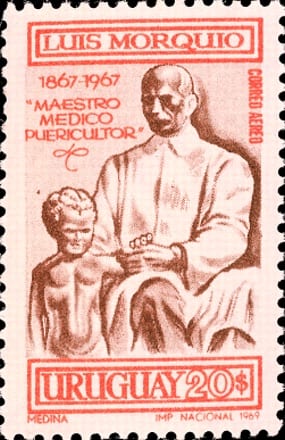Luís Morquio

Luís Morquio (1867-1935) was a Uruguayan paediatrician.
Born in Montevideo in 1867, son to Italian immigrants. His father was a shoemaker from Genova. As a young man he attended the school of human sciences directed by his uncle. His first profession was as a bookkeeper in different shops in Montevideo- with this he financed his medical studies.
After graduating as a doctor, he realised his instruction in Paediatrics had been quite poor; hence he left to Europe, where paediatrics as a recognised field had begun to emerge only 20 years prior. Upon his return in 1900, he was appointed professor of the children’s clinic in Montevideo.
In 1930, Morquio is named director of the institute of paediatrics & childcare. During his career he gained international reputation, drawing students in paediatrics to his lectures, mainly from the neighbouring countries of Argentina, Brazil, Paraguay and Chile.
His publication record spanned over 300 works- publications, books and articles, which were held in especially high regard in France.
Biography
- Born on September 24, 1867
- 1887-1890 Medical degree, University of Montevideo
- 1892 – MD, thesis on the treatment of typhoid fever.
- 1893-1894 Further training in paediatrics in Paris at the Pasteur Institute and clinics of Marfan and Charcot
- 1900 – Full Professor of Paediatrics, Montevideo
- 1915 – Founder of Sociedad Uruguaya de Pediatría
- 1930 – President of the International Save the Children Fund, Geneva
- Died on June 19, 1935
Medical Eponyms
Morquio syndrome (1929) [Morquio-Brailsford syndrome]
Severe form of skeletal dysplasia that had previously associated with cretinism and achondroplasia. Identified independently by Morquio and Brailsford in 1929. One of the group of hereditary specific lysosomal enzyme deficiencies which cause pathological accumulation and urinary excretion of incompletely degraded mucopolysaccharides. [mucopolysaccharidosis type IV]
Rare storage disease characterised by skeletal dysplasia (short trunk dwarfism); cervical cord compression; hepatomegaly; aortic incompetence; and deafness. Occurs in two forms depending on which gene is mutated:. A: with a deficiency of the enzyme galactosamine-6-sulphate sulphatase; B: with a deficiency of the enzyme B-galactosidase. Inheritance is autosomal recessive; familial influences are common.
In 1929, Morquio reported on a form of ‘familial skeletal dystrophy’ affecting four of five children born to consanguineous parents of Swedish descent.
Charles, âgé de huit ans, naissance normale, nourri au sein pendant six mois.
On est frappé de la déformation du thorax, qui est prédominante… Le cou parait très court, la tête semble sortir directement du thorax. Proéminence sternal pointue, anguleuse, égale à celle de sa sôeur. Thorax très court, agrandi à sa base. Pas de chapelet costal. Abdomen gros, saillant.
Jambes en gene valgus. L’enfant peut marcher à petits pas, lentement, faisant des mouvements d’un côté à l’autre, comme un canard.
On ne trouve à l’origine de cette affection aucune cause de nature infectieuse ou toxique… Mais il faut tenir compte de la consanguinité des parents (cousins germains) eux-mêmes descendant aussi d’autres parents consanguins, ce qui augmente les caractères transmissibles.
Charles, aged eight years, normal birth, breastfed for six months.
One is struck by the deformity of the thorax, which is predominant… The neck is very short, the head appears to protrude directly from the thorax. Pointed sternal prominence, angulated, similar to that of his sister. Very short thorax, widened at its base. No rachitic rosary (costochondral thickening characteristic of Rickets). Large, protruding abdomen.
Legs in genu valgus. The child can walk small steps, slowly, hobbling from one side to the other like a duck.
One cannot determine any infectious or toxic nature at the origin of this affectation… But it must be remembered that the parents are consanguineous (cousins), themselves descending from other consanguineous parents, which increases the transmissible characteristics.
Also in 1929, James Frederick Brailsford (1888 – 1961) provided an independent account of the clinical and radiological features of a child with ‘chondro-osteo-dystrophy’
Major Publications
- Morquio L. Sur une maladie infantile et familiale caractérisée par des modifications permanentes du pouls, des attaques syncopales et épileptiformes et la morte subite. Archives de médecin des enfants. 1901; 4: 467-475 [Jervell and Lange-Nielsen syndrome]
- Morquio L. La cuna del Asilo de Expósitos y huérfanos : memoria, 1902
- Morquio L. Los desarreglos gastro intestinales del lactante. 1918
- Morquio L. La endocarditis maligna en la infancia. Archivos españoles de pediatría, 1918.
- Morquio L. Los desarreglos gastro intestinales del lactante. Talleres Gráficos A. Barreiro y Ramos, 1919
- Morquio L. Sobre leucemias agudas (conclusión). [Artículo de revista]. Archivos españoles de pediatría, 1923.
- Morquio L. Sur une forme de dystrophie osseuse familiale. Archives de médecine des enfants. 1929, 32: 129-135. [Morquio syndrome]
- Morquio L. Clínica infantil. 1928
- Morquio L. El problema de la mortalidad infantil. 1931
- Barbato D, Morquio L. Clínica de niños : apuntes de clases del prof. Morquio. 1936
References
Biography
- Fotografía de Luis Morquio 1867 – 1935. Médico y profesor uruguayo. circa 1930
- Alfaro GA. La vida y la obra científica del Profesor Morquio. Montevideo García Morales 1935
- 20c Stamp. Stanley Gibbons 1411, 1969
- Wiedemann. Luis Morquio. European Journal of Pediatrics. 1992; 151(8): 549
- Bibliography. Morquio, Luis 1867-1935. WorldCat Identities
Eponyms
- Haas L. Luis Morquio (1867–1935). J Neurol Neurosurg Psychiatry. 2002; 72(6): 787.
- Turnes, A. Luis Morquio, fundador de la Sociedad Uruguaya de Pediatria. Arch. Pediatr. Urug. 2015; 86(3)

[cite]
Resident medical officer in emergency medicine MB ChB (Uni. Dundee) MRCS Ed. Avid traveller, yoga teacher, polylinguist with a passion for discovering cultures.

